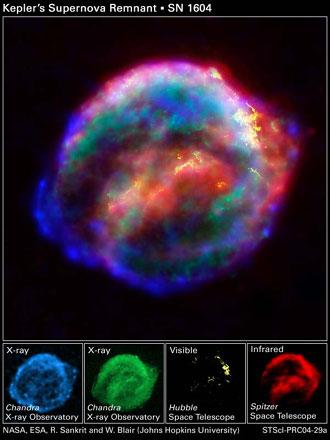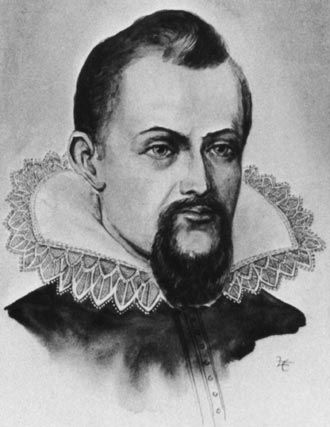About four hundred years ago, astronomy enthusiasts from all over the world (including Johannes Kepler - best known as the discoverer of the laws of planetary motion) were amazed by the sudden appearance of a "new star" in the western sky
Amit Oren
For X-ray absorption, yellow - images taken with the help of the space telescope"]
The images appear in order, from left to right.
For an enlarged image, click here
Direct link to this page: https://www.hayadan.org.il/keplersn.html
About four hundred years ago, astronomy enthusiasts from all over the world (including Johannes Kepler - best known as the discoverer of the laws of planetary motion) were amazed by the sudden appearance of a "new star" in the western sky, which rivaled the brightness of the nearest planets. That "star" - was a supernova.
Using NASA's three largest telescopes for the occasion, astronomers today are unraveling the mystery surrounding the expanding remnants of that supernova [also known as the "Kepler supernova"], which is considered the last supernova known and reported to have occurred within the Milky Way galaxy .
When the new star appeared on October 1604, XNUMX, observers and astronomers could only use their naked eyes to observe it. The Galilean telescope [the light breaker] - was invented only after four years.
A group of astronomers today have the ability to use the combined tools found in NASA's advanced space telescopes. With the help of the three telescopes [Hubble Space Telescope, Chandra, and Spitzer], astronomers can analyze the supernova remnants in three basic wavelengths: infrared, visible light, and X-rays.
The team of researchers is led by two researchers. One of them is Ravi Sankrit, a partner and scientist in the study, who works at the Center for Astrophysical Sciences at Johns Hopkins University in Baltimore, and leads the observations of the astronomical content of the Hubble Space Telescope. The second team leader is William Blair, a research professor, and works in the Physics and Astronomy Division of the same university. Also: Blair leads the Spitzer Space Telescope observations for this topic.
The combined image reveals a kind of bubble shell of gas and dust, which is about 14 light years wide, and expanding at a rate of about 6 million km/h.
From any telescope you can see different characteristics of a supernova, but the main characteristic seen in it is the rapid movement of the mantle, which is made of material rich in iron, and around it - the spread of a shock wave that sweeps interstellar gas and dust.
"Studies of celestial bodies at many wavelengths at the same time are necessary to establish a complete picture of the development of supernova remnants," Sankarit said.
"For example, in the infrared data we mainly see the interstellar dust that has heated up, while observations in the visible light and X-ray fields allow us to know different temperatures of gases," added Blair, "several observations are required in order to understand the complicated relationship regime that exists between the various components of the system. "

.
Kepler documented the supernova scenario in 1604, which was the last one we know of to have been reported in the Milky Way galaxy where we are. The same supernova to this day is named after him - the Kepler supernova.
Image credit: California Institute of Technology Archives.
The explosion of a star is a catastrophic event. The impact tears apart the star and releases a destructive spherical shock wave, which spreads outward at a speed of over 35 million km/h, simulating an interstellar tsunami. The shock wave spreads into the near space, and sweeps with it thin gas and dust that it encounters in its path, with which it forms a tremendous envelope.
The remnants of the stellar material are finally left behind the shock wave, caught with the inner side of the mantle and heated to temperatures at which X-rays are emitted to an extent convenient for measurement.
Visible light images taken by the Hubble Space Telescope reveal where the supernova's shock wave "slams" dense gas regions. In the picture at the top of the page, you can see that the bright and "glowing" areas are dense clumps of material - which were formed behind the shock wave. Sankrit and Blair compared Hubble's observations and images to those of the ground-based telescopes, thus obtaining an average distance to the supernova - of approximately 13,000 light years.
The astronomers used the Spitzer space telescope to study the material that emits radiation in infrared light, which probably shows dust particles that were swept away by the shock wave that followed the supernova.
"Spitzer" is sensitive enough to distinguish the two dense regions visible by the Hubble, and likewise; In the entire shock wave - a spherical cloud of material. The instruments on Spitzer also reveal information regarding the chemical composition and physical environment of gas and dust clouds that spread into space. The dust is similar to the dust that was part of the formation of our solar system.
The Chandra space telescope shows regions of hot gas. The hottest gas, which emits the highest amount of X-ray radiation, is located mainly in the regions behind the shock wave front.
These areas are also visible in Hubble's images, and connect to those faded areas also visible in Spitzer's images.
Colder gas, which emits X-rays at a lower level, is found in a thick mantle layer and marks the area where material has been detached from the exploded star.
We know of six supernovae that have occurred in our solar system in the last millennium. The "Kepler supernova" is the only one in which astronomers do not know what kind of star ended its life.
By combining the information from the three space telescopes, the astronomers hope to find the clues they need.
"This is really a situation where the outcome is greater than the sum of the variables," Blair said, "When we finish analyzing the outcomes and the variables, we will be able to answer a number of questions about this shrouded in mystery."
Photos and more information:
NASA website
The mourning news
Chandra site
to the Spitzer site
The Hubble Space Telescope Heritage Site
For information on the NASA website
